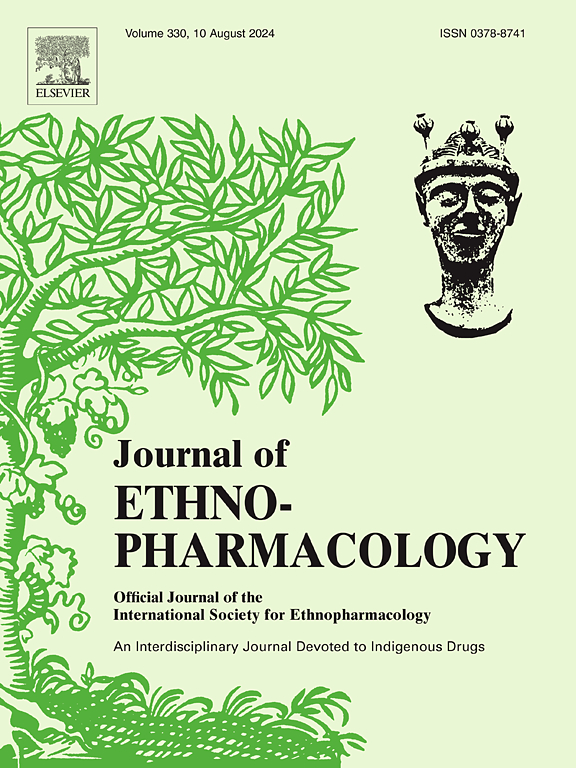Rapid screening of active ingredients in traditional Chinese medicine based on bar-form-diagram fingerprint combined with spectrum-effect relationship
IF 4.8
2区 医学
Q1 CHEMISTRY, MEDICINAL
引用次数: 0
Abstract
Ethnopharmacological relevance
The discovery of active ingredients in traditional Chinese medicine (TCM) is vital for its modernization. However, the complex composition and varying component contents often cause trace ingredients to be overlooked during screening. It is crucial to develop a key screening technology for active ingredients in TCM.
Aim of the study
This study aimed to construct a spectrum-effect relationship analysis method based on the bar-form-diagram (BFD) combined with chemometrics. Gardenia jasminoides root was selected as an example to screen its active ingredients with hepatoprotective effects.
Materials and methods
The BFD was established through penalized least-squares background fitting, and peak area calculation by composite Simpson's rule. Hepatoprotection was evaluated by measuring the levels of AST, ALT, NO, IL-6, IL-1β, and TNF-α. Grey relational analysis (GRA), partial least squares regression (PLSR), Pearson correlation analysis and multidimensional feature network analysis were used to screen potential components. Furthermore, the high-resolution peak fractionation (HRPF) strategy was used for further active screening. The active components that could serve as quality control markers (Q-markers) were discriminated by multidimensional feature network analysis.
Results
The results showed that based on BFD, 35 common peaks were identified from 52 chromatographic peaks, which was superior to the 23 in regular fingerprints. In the spectrum-efficacy analysis, 20 candidates were screened from six indicators. HRPF showed 15 fractions exhibited favorable effects, with the inhibition rate greater than 50 %. After integration analysis, eight key Q-markers responsible for the hepatoprotection were determined, including rutin, kaempferol-3-O-sophoroside, chikusetsusaponin Iva, chlorogenic acid, isochlorogenic acid C, caffeic acid, isochlorogenic acid A, and isochlorogenic acid B. These Q-markers were stably detected in ten batches of Gardenia jasminoides root samples, and the RSD of their contents were all less than 5.0 %.
Conclusions
A novel BFD fingerprint combined with spectrum-effect relationship was successfully developed and applied to discover the Q-markers of Gardenia jasminoides root based on multidimensional feature network. It facilitates the quick screening of active ingredients in the complex systems of TCM.

基于条形图指纹图谱结合谱效关系的中药有效成分快速筛选
民族药理学相关性:中药有效成分的发现对其现代化至关重要。然而,由于其组成复杂,成分含量多变,在筛选过程中往往会忽略微量成分。开发中药有效成分的关键筛选技术至关重要。研究目的:本研究旨在构建一种基于条形图(BFD)与化学计量学相结合的光谱效应关系分析方法。以栀子根为例,筛选其保肝活性成分。材料与方法:采用惩罚最小二乘背景拟合建立BFD,采用复合辛普森规则计算峰面积。通过测定AST、ALT、NO、IL-6、IL-1β和TNF-α水平来评价肝保护作用。采用灰色关联分析(GRA)、偏最小二乘回归(PLSR)、Pearson相关分析和多维特征网络分析筛选潜在成分。此外,采用高分辨率峰分馏(HRPF)策略进行进一步的主动筛选。通过多维特征网络分析,识别出可作为质量控制标记的活性成分。结果:基于BFD技术,从52个色谱峰中鉴定出35个共同峰,优于常规指纹图谱的23个共同峰。在光谱-功效分析中,从6个指标中筛选出20个候选药物。HRPF有15个组分表现出良好的抑菌效果,抑菌率大于50%。通过整合分析,确定了芦丁、山奈酚-3- o -苦参苷、苦参皂苷Iva、绿原酸、异绿原酸C、咖啡酸、异绿原酸A、异绿原酸b等8个保肝关键q -标志物,这些q -标志物在10批栀子根样品中均有稳定检测,其含量的RSD均小于5.0%。结论:成功建立了一种结合光谱效应关系的新型BFD指纹图谱,并将其应用于基于多维特征网络的栀子根q标记的发现。它有助于在复杂的中药系统中快速筛选有效成分。
本文章由计算机程序翻译,如有差异,请以英文原文为准。
求助全文
约1分钟内获得全文
求助全文
来源期刊

Journal of ethnopharmacology
医学-全科医学与补充医学
CiteScore
10.30
自引率
5.60%
发文量
967
审稿时长
77 days
期刊介绍:
The Journal of Ethnopharmacology is dedicated to the exchange of information and understandings about people''s use of plants, fungi, animals, microorganisms and minerals and their biological and pharmacological effects based on the principles established through international conventions. Early people confronted with illness and disease, discovered a wealth of useful therapeutic agents in the plant and animal kingdoms. The empirical knowledge of these medicinal substances and their toxic potential was passed on by oral tradition and sometimes recorded in herbals and other texts on materia medica. Many valuable drugs of today (e.g., atropine, ephedrine, tubocurarine, digoxin, reserpine) came into use through the study of indigenous remedies. Chemists continue to use plant-derived drugs (e.g., morphine, taxol, physostigmine, quinidine, emetine) as prototypes in their attempts to develop more effective and less toxic medicinals.
 求助内容:
求助内容: 应助结果提醒方式:
应助结果提醒方式:


